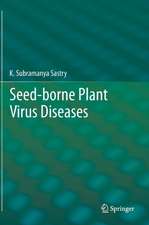Plant Virus and Viroid Diseases in the Tropics: Volume 2: Epidemiology and Management
Autor K. Subramanya Sastry, Thomas A. Zitteren Limba Engleză Hardback – 21 ian 2014
| Toate formatele și edițiile | Preț | Express |
|---|---|---|
| Paperback (1) | 1227.21 lei 6-8 săpt. | |
| SPRINGER NETHERLANDS – 23 aug 2016 | 1227.21 lei 6-8 săpt. | |
| Hardback (1) | 1239.37 lei 6-8 săpt. | |
| SPRINGER NETHERLANDS – 21 ian 2014 | 1239.37 lei 6-8 săpt. |
Preț: 1239.37 lei
Preț vechi: 1511.42 lei
-18% Nou
Puncte Express: 1859
Preț estimativ în valută:
237.16€ • 248.23$ • 197.39£
237.16€ • 248.23$ • 197.39£
Carte tipărită la comandă
Livrare economică 01-15 aprilie
Preluare comenzi: 021 569.72.76
Specificații
ISBN-13: 9789400778191
ISBN-10: 9400778198
Pagini: 489
Ilustrații: XXV, 489 p. 39 illus., 24 illus. in color.
Dimensiuni: 155 x 235 x 27 mm
Greutate: 1.07 kg
Ediția:2014
Editura: SPRINGER NETHERLANDS
Colecția Springer
Locul publicării:Dordrecht, Netherlands
ISBN-10: 9400778198
Pagini: 489
Ilustrații: XXV, 489 p. 39 illus., 24 illus. in color.
Dimensiuni: 155 x 235 x 27 mm
Greutate: 1.07 kg
Ediția:2014
Editura: SPRINGER NETHERLANDS
Colecția Springer
Locul publicării:Dordrecht, Netherlands
Public țintă
ResearchCuprins
Chapter I - Ecology and Epidemiology of Virus and Viroid Diseases of Tropical Crops.- 1.1 Introduction.- 1.2 Epidemiological concepts.- 1.3 Conditions favorable for epiphytotics-. 1.4 Cropping systems and practices.- 1.5 Host properties.- 1.6 Pathogen properties.- 1.7 ICTV recognized viruses.- 1.8 Pathways of virus spread.- 1.9 Dispersal and Migration of Insect vectors.- 1.10 Factors of Vector transmission.- 1.11 Virus Survival and spread.- 1.12 Disease forecasting.- 1.13 The cyclical nature of plant disease.- 1.14 Disease progress curve.- 1.15 Growth models for disease progress.- 1.16 Spatial dynamics and metapopulations.- 1.17 Disease gradients and progress curves.- 1.18 Mathematical modeling techniques .- 1.19 Virus-vector population model.- 1.20 Systems Analysis and Simulation Models.- 1.21 Conclusions.- Chapter II - Management of Virus and Viroid Diseases of Crops in the Tropics.- 2.1 Introduction.- 2.2 Need for diagnosis of plant virus and viroid diseases.- 2.3 Approaches forvirus and viroid diseases management.- 2.4 Use of virus / viroid-free vegetative propagules and true seed.- 2.5 Certification schemes of crops having virus transmission through true seed.- 2.6 Virus and viroid disease transmission through Vegetative propagules.- 2.7 Success stories of production of virus-free plant propagules.- 2.8 Certification schemes of economically important crops.- 2.9 Production and use of virus-free transplants .- 2.10 Need for managing the virus diseases.- 2.11 Avoidance of sources of infection / inoculums.- 2.12 Variation of the crop cultural practices.- 2.13 Cross-protection in crop plants.- 2.14 Vector control.- 2.15 Role of botanicals in plant virus management.- 2.16 Role of oils in arthropod vector control.- 2.17 Biological control of plant virus vectors.- 2.18 Avoidance of vectors.- 2.19 Role of repelling and attracting surfaces in vector control.- 2.20 Resistance.- 2.21 Transgenic approach.- 2.22 Bio-safety regulations against GM Crops.- 2.23 Induction of systemic resistance.- 2.24 Quarantines.- 2.25 Pest risk analysis (PRA).- 2.26 World Trade Organization regime and its implications.- 2.27 Plant biosecurity.- 2.28 Role of IPGRI and NBPGR in germplasm maintenance and exchange .- 2.29 Role of FAO / IBPGR in germplasm exchange.- 2.30 Methods of testing at quarantine stations.- 2.31 Important cases of introduction.- 2.32 Important diseases restricted to some countries .- 2.33 Effective methods of plant importations.- 2.34 General principles for the overall effectiveness of quarantines .- 2.35 Need for networking for the developing countries.- 2.36 Integrated approach.- 2.37 Challenges for the future.
Recenzii
“The book provides an effective and comprehensive information on epidemiology and management aspects of virus and viroid diseases in tropics which is well written by the authors, regarding present status and possible feature strategies in holistic plant virus/vorid disease management. It should find a well-deserved place in the laboratories of different institutions and universities engaged in teaching and research in plant pathology and plant virology.” (V. Muniyappa, Virus Disease, Vol. 27, 2016)
Textul de pe ultima copertă
Many of the world's most important food crops are grown in the tropics and the majority of them are affected with one or another virus or viroid diseases. Plant virus and sub-viral agents are one of the factors that affect productivity and cause vast economic losses to staple crops across the tropics. Sustained efforts are being made in universities and research institutions of both state and central facilities, and have resulted in dramatic success in managing some of the most devastating virus diseases. However, emergence of new viruses and strains of existing viruses, along with changing contexts due to agricultural intensification and climate change resulted in creating new challenges and demanding even greater effort to overcome hurdles to increase agricultural productivity, food availability and economic development.
Methods for the detection and identification of viruses and virus-like diseases in plants and vectors play a critical role in plant virus epidemiologyand in turn plant virus management. Advancements in serological and molecular techniques have greatly improved the speed and accuracy of virus and sub-viral pathogen identification. To keep up with the constant threat of emerging and re-emerging plant viruses, it is necessary to identify, predict and monitor sources of outbreaks at the worldwide level to minimize small infection proportions from becoming devastating pandemics. Diagnosis of plant virus and sub-viral agents and their prevention / management is an integral part of agricultural production systems and regulatory frame works that exist in almost all tropical countries.
Plant virus epidemiology provides powerful tools to investigate key factors that contribute to virus epidemics in agricultural crops. These epidemiological approaches help to guide decisions regarding plant protection strategies. The dynamics of a particular virus disease epidemic depends on the number of vectors and their activity, sources of virus and vectors, climatic conditions and a complex series of virus - plant - vector interactions. The importance of epidemiology needs to be realized for the management of virus diseases in an integrated disease management program (IPM) and also for generating information on pest / disease-free areas and for pest risk analysis, which is an obligation for our international trade. Even though there are number of virus and virus-like disease management measures, whenever individually are used alone, the benefits received are very small and may become infective with time. On other hand, in an integrated approach, when different ways of virus management measures are combined and used together, there would be effective overall reduction or control of virus and sub-viral diseases. Integrated virus management strategies are to be comprehensive, effective and should protect farmers from economic hardships due to crop losses because of virus and virus-like diseases. The virus management strategies developed must be robust and involve minimum extra expenditure. This book is an excellent latest source of information for those interested in plant virus teaching, research and virus management. It is also invaluable resource for research workers, educators, students of plant virology, plant pathology, plant breeding, biotechnology, molecular biology.
Methods for the detection and identification of viruses and virus-like diseases in plants and vectors play a critical role in plant virus epidemiologyand in turn plant virus management. Advancements in serological and molecular techniques have greatly improved the speed and accuracy of virus and sub-viral pathogen identification. To keep up with the constant threat of emerging and re-emerging plant viruses, it is necessary to identify, predict and monitor sources of outbreaks at the worldwide level to minimize small infection proportions from becoming devastating pandemics. Diagnosis of plant virus and sub-viral agents and their prevention / management is an integral part of agricultural production systems and regulatory frame works that exist in almost all tropical countries.
Plant virus epidemiology provides powerful tools to investigate key factors that contribute to virus epidemics in agricultural crops. These epidemiological approaches help to guide decisions regarding plant protection strategies. The dynamics of a particular virus disease epidemic depends on the number of vectors and their activity, sources of virus and vectors, climatic conditions and a complex series of virus - plant - vector interactions. The importance of epidemiology needs to be realized for the management of virus diseases in an integrated disease management program (IPM) and also for generating information on pest / disease-free areas and for pest risk analysis, which is an obligation for our international trade. Even though there are number of virus and virus-like disease management measures, whenever individually are used alone, the benefits received are very small and may become infective with time. On other hand, in an integrated approach, when different ways of virus management measures are combined and used together, there would be effective overall reduction or control of virus and sub-viral diseases. Integrated virus management strategies are to be comprehensive, effective and should protect farmers from economic hardships due to crop losses because of virus and virus-like diseases. The virus management strategies developed must be robust and involve minimum extra expenditure. This book is an excellent latest source of information for those interested in plant virus teaching, research and virus management. It is also invaluable resource for research workers, educators, students of plant virology, plant pathology, plant breeding, biotechnology, molecular biology.
Caracteristici
In tropical countries virus and virus-like diseases cause enormous yield losses and hence demands effective management measures Understanding the plant virus epidemiology is vital to formulating viable disease management practice in a given agro-ecosystem Approaches for effective management of virus diseases viz., production of virus free plant materials and certification schemes, vector control through chemical and non-chemical methods, resistance breeding and transgenic plants Includes supplementary material: sn.pub/extras





